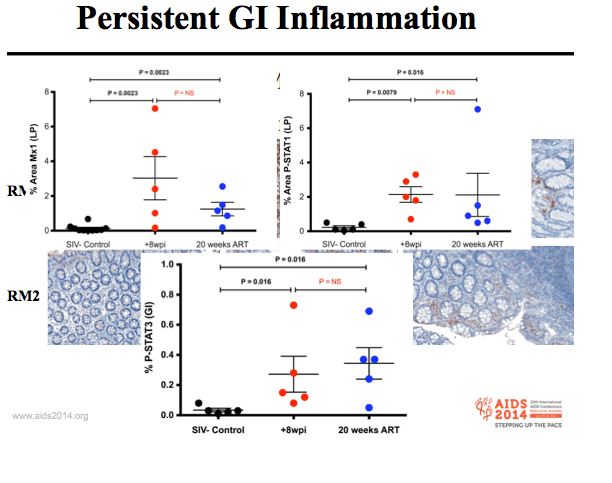 |
 |
 |
| |
SIV-infected rhesus macaques receiving suppressive cART have continued GI damage, inflammation, immune activation and persistent low-level viral replication within lymphoid tissues..."Suggesting that HIV Cure strategies will need to address sources of residual inflammation/immune activation to be successful"
|
| |
| |
Reported by Jules Levin
20th International AIDS Conference, 20-25 July, 2014, Melbourne, Australia
"While immune activation (KI67) and inflammation (MxA and TNF-α) in lymph nodes and the GI were attenuated after suppressive cART compared to pre-ART, they still remained significantly elevated compared to SIV- controls. Persistent GI damage, as measured by PMN infiltration (MPO staining), was still evident after 20 weeks of cART and significantly greater than SIV- RMs. Importantly, while the level of SIV vRNA+ cells were significantly reduced after cART evidence for persistent low-level viral replication were detected within lymphoid tissues in most animals.
Conclusions: Persistent GI damage, inflammation and immune activation is still evident in RMs after 20 weeks of cART and may explain, in part, why continued low-level viral replication still occurs in lymphoid tissues."
Presented by Jacob Estes (United States).
C. Deleage1, J. McCune2, T. Schacker3, J. Estes1
1Frederick National Laboratory for Cancer Research, Leidos Biomedical Research, Inc., AIDS & Cancer Virus Program, Frederick, United States, 2University of California, Department of Medicine, Division of Experimental Medicine, San Francisco, United States, 3University of Minnesota, Department of Medicine, Minneapolis, United States


----------------------------
Background: A detailed understanding of the mechanisms for long-lived viral reservoir maintenance will likely be key to designing successful strategies for an HIV functional cure. Persistent inflammation and immune activation may lead to on-going low levels of viral replication in the setting of suppressive cART resulting in continued reservoir persistence. Major gaps still exist in our understanding of viral reservoir maintenance that are particularly difficult, if not impossible, to study in humans, however, studies in nonhuman primates provide ideal models to address this important question.
Methods: 5 rhesus macaques (RM) were infected with SIVmac251 and at 8 wpi received a five-drug regimen of cART (FTC/PMPA/Raltegravir/Darunavir/Ritonavir) for 20 weeks at which time the animals were necropsied with a comprehensive tissue collection for each animal. In situ hybridization, immunohistochemistry and quantitative image analysis was performed on lymph nodes (axillary, inguinal, mesenteric), spleen, GI (jejunum and colon), liver, and lung to comprehensively determine the level of persistent viral replication, GI damage (PMN infiltration; MPO staining), inflammation (MxA, TNF-α), and immune activation (KI67) in the setting of suppressive cART.
Results: While immune activation (KI67) and inflammation (MxA and TNF-α) in lymph nodes and the GI were attenuated after suppressive cART compared to pre-ART, they still remained significantly elevated compared to SIV- controls. Persistent GI damage, as measured by PMN infiltration (MPO staining), was still evident after 20 weeks of cART and significantly greater than SIV- RMs. Importantly, while the level of SIV vRNA+ cells were significantly reduced after cART evidence for persistent low-level viral replication were detected within lymphoid tissues in most animals.
Conclusions: Persistent GI damage, inflammation and immune activation is still evident in RMs after 20 weeks of cART and may explain, in part, why continued low-level viral replication still occurs in lymphoid tissues.
---------------------------






|
| |
|
 |
 |
|
|